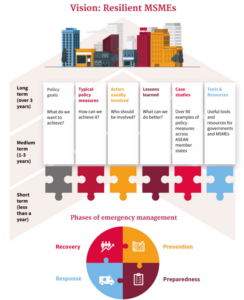Reports and articles
Beyond COVID-19: What can be done to enhance the resilience of MSMEs?
Published on September 13th 2022
Micro-, small- and medium-sized enterprises (MSMEs) make up the backbone of national economies and are essential to many livelihoods. Globally, nine in every 10 businesses are MSMEs, six in every 10 jobs are created by MSMEs, and half of the gross domestic product is generated by them. Their contribution to the economy and their role in stimulating domestic demand means they are critical for post-COVID-19 recovery and future socio-economic resilience.
However, MSMEs face significant challenges that hinder their development and, in some cases, their survival. They face barriers accessing finance and attracting talent, as well as reaching markets and innovating. And because of these constraints on resources and capacity, MSMEs tend to be more vulnerable to crises and disasters.
Reflections from the ASEAN region
The Association of Southeast Asian Nations (ASEAN) region is one of the most hazard- prone in the world, accounting for one in every 10 disasters triggered by natural hazards during the past 120 years. Although this makes ASEAN MSMEs more exposed to disasters, it has also contributed to the development of public, private and social capacity to cope with natural and human-made hazards.
During the COVID-19 pandemic, MSMEs were disproportionally affected. In the ASEAN region, some of the main impacts MSMEs faced included: interruption of operations, supply chain disruptions, demand contraction, lack of liquidity and staff lay-offs.
Impacts, however, were unequal across population groups. For instance, women-led MSMEs were more likely than men-led MSMEs to temporarily close their businesses and to reduce their workforce. Women also faced greater losses in sales and revenue.
Challenges and opportunities
Although there are many initiatives supporting MSMEs in the ASEAN region and these saw a substantial expansion during the COVID-19 pandemic, MSMEs tend to face multiple barriers in accessing this support. This is particularly the case for smaller businesses and those not formally registered.
Common barriers faced by MSMEs include: a lack of clarity in application processes; slow application and approval processes; not being formally registered; a lack of collateral; and other difficulties meeting the eligibility criteria of programmes. Easing application processes and the eligibility criteria can help MSMEs overcoming these barriers, especially in times of crises.
We also identified a mismatch between MSMEs’ needs and the support available. Although exceptions were found, MSME support programmes tended to place less attention on measures to prevent risks and in preparing businesses to deal with hazards such as floods, droughts and infectious disease outbreaks. Opportunities for policy development and coordination therefore include: business continuity planning and management; disaster risk prevention and management; and supplier development programmes.
Opportunities also exist for increasing collaboration between MSME development agencies, disaster risk-management organisations and business associations. Disaster risk-management organisations have relevant knowledge and experience in preventing and preparing population to hazards, however they tend to have limited links with MSMEs and MSME development agencies. Business associations can also play a key role in disseminating information on hazards and their impacts, as well as reaching out to MSMEs in crises and disasters.
What can be done to enhance the resilience of MSMEs?
In the Regional Guidelines we present more than 90 examples of policy measures across the 10 ASEAN Member States that can contribute to enhance the resilience of MSMEs: from public risk insurance programmes and furlough schemes to programmes supporting the adoption of digital technologies, promoting gender inclusive innovation, and financing green transformations.
Based on these case studies, the guidelines describe typical actors and budgets involved in the design and delivery of policy measures, and lessons learned from the COVID-19 pandemic and previous crises, such as the devastation caused by multiple typhoons in the Philippines in 2008 and 2009 and floods in Thailand in 2011. Useful tools and resources for governments and enterprises are also part of the guidelines, including: policy toolkits, business continuity guides and digital readiness self-assessment tools.
The Regional Guidelines are structured around the four phases of disaster risk management as identified by the United Nations Office for Disaster Risk Reduction (UNDRR), as follows:
- Prevention
Prevention measures are aimed at reducing the vulnerability and exposure of MSMEs to hazards. An example of these measures is the Philippines’ Agricultural Insurance Program. It was designed to protect subsistence farmers and fisherfolk, covering seven insurance lines: rice crops, corn crops, high-value crops, livestock, fisheries, aquaculture and non-crop agricultural assets.# - Preparedness
Preparedness measures are aimed at developing the knowledge and capacity among MSMEs and public actors to anticipate and respond in a timely way to the impacts of disasters and crises. iPrepare Business facility is an example of a preparedness initiative. In Thailand, iPrepare Business partnered with Isuzu Motors Company to provide direct technical support on business continuity management to automotive suppliers in disaster-risk-prone areas. The technical support delivered to the Isuzu suppliers consisted of four in-house business continuity management training workshops. - Response
Response measures involve actions taken directly before, during or immediately after a disaster in order to minimise its impacts. During the COVID-19 pandemic, digital technologies became a key enabler of business continuity. As a result, different government launched and expanded support in this area. Community for Brunei is an example of these, a large-scale digital platform launched in April 2020 by Bank Islam Brunei Darussalam to support small business and provide consumers with a safe way to continue their purchases. - Recovery
Recovery measures are aimed at restoring and improving MSMEs’ performance after a crisis or disaster. A resilient recovery involves not only restoring business performance to pre-crisis levels but also doing so while reducing future disaster risks and closing inequality gaps.In the face of the climate crisis and the social and economic inequalities COVID-19 exposed and deepened, policy measures aimed at supporting green transformations and the economic inclusion of women and other underrepresented groups are essential for a resilient recovery.For example, the Malaysian Green Technology and Climate Change Centre, through its Green Technology Financing Scheme, provides loans for developing or adopting green technologies and for improving energy efficiency or the use of renewable energy resources.Another example is Cambodia’s Leading the Way for Gender Equality (LGWE) programme which addresses gender inequalities. The LWGE programme involves policy development and monitoring for gender equality and gender mainstreaming; the promotion of women in public decision-making; the engagement of young people, media and educational institutions for gender equality; and the inclusion of disadvantaged groups of women and girls; among other goals and actions.
The figure presented below summarises the structure of the guidelines and the key components included in them.
Structure and key components of the Regional Guidelines

Next steps for building resilience
In moving forward, it is important to take stock from the lessons learned from the COVID-19 pandemic and previous crises and disasters, identify potential policy and governance gaps, and to evaluate the effectiveness of policy measures and communication channels. We therefore encourage policy makers and other relevant actors to use the Regional Guidelines as a benchmark to assess current capacity and governance structures.
To be prepared for future crises and disasters, governments can develop national roadmaps setting a shared vision, establishing coordination mechanisms, and identifying public- and private-sector ‘champions’ that could move policies forward to enhance the resilience of MSMEs in the short-, medium- and long-term.
For further information please contact:
Jennifer Castañeda-Navarrete
+44(0)1223 766141jc2190@cam.ac.ukConnect on LinkedInAbout the report
The Regional Guidelines were envisaged by the ASEAN Coordinating Committee on Micro, Small and Medium Enterprises (ACCMSME) and supported by the Australian government through the ASEAN–Australia Development Cooperation Program Phase II. Consultations for this project were conducted in partnership with Sociedade Portuguesa de Inovação.
At Cambridge Industrial Innovation Policy, we work with governments and international development actors to inform the design and implementation of industrial and innovation policies. We base our work on the latest academic thinking and international best practice. We combine these with careful study of the specific contexts, usually in collaboration with local partners, to identify sound and practical policy options. Find out more about working with us.
Related resources
Find out how we help connect world-leading researchers with international governments and policymakers


